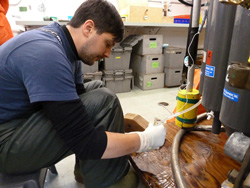Steve Lambert, WHOIAugust 9, 2012One of the oldest and most reliable ways of measuring ocean dynamics is by sampling the water at different depths. First used by early Trans-Atlantic mariners as a navigation aid, water sampling can tell us much about the ocean. By taking samples at different depths we can see how the water has changed with respect to location, time, and depth. The rosette is a round cage or frame that houses anywhere from a couple of sampling bottles to thirty or more. The larger the rosette the larger the ship required to handle it and the necessary wire, winch, and crane. The unit found aboard the LSSL is on the larger side and at the moment it carries 24 sample bottles. These bottles are cocked open prior to deployment and then triggered at a given depth; when they slam shut they trap water, taking a sample for that depth. Along with the bottles, the rosette carries a CTD which measures ocean salinity by a conductivity probe (the more conductive the water, the more salt it contains), a temperature probe or thermister, and pressure sensor. Density can be taken from temperature and salinity and depth taken from pressure and density. This is all done very quickly with processing software. The samples with the bottles are then categorized by stages - dissolved oxygen, carbon dioxide, etc. then processed separately. We are seeing more and more gulls hanging around the ship and got to see a couple of polar bears last night. Congrats to the U.S. women's soccer team on winning the gold, Japan for the silver, and Canada for the bronze! Last updated: October 7, 2019 | |||||||||||||||||
Copyright ©2007 Woods Hole Oceanographic Institution, All Rights Reserved, Privacy Policy. | |||||||||||||||||



